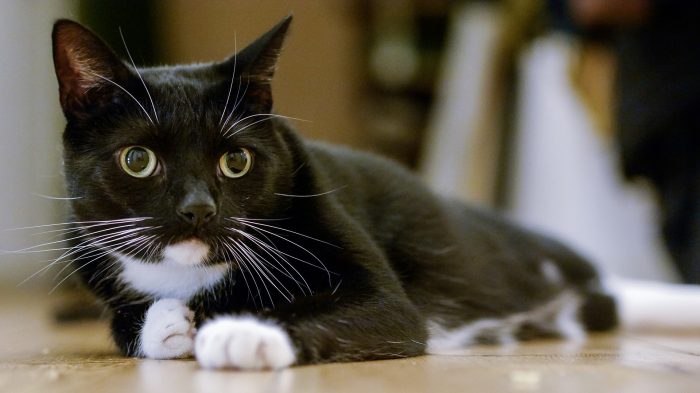Hopefully your beloved cat will be completely healthy for his entire life, but unfortunately, that’s generally not the way life works. At some point, your cat may even experience a seizure, which is scary for both pet and owner. When this occurs, your first reaction might be to panic, but this isn’t helpful for anyone.
If you want to help your cat when he has a seizure, follow this guide to help find the cause and learn your cat’s treatment options.
What is a seizure?
Before you can do anything, you need to understand what a seizure actually is. Like in humans, a cat seizure is a sudden surge of electrical activity in the brain. This surge can come from a number of causes, including genetic, environmental and physical. Whatever the source, the cause of the electrical activity is complex chemical changes that are occurring in your cat’s nerve cells.
Brain cells will either excite or inhibit other brain cells from sending messages. There is usually a healthy balance of these cells, but when a seizure occurs, it can create too much or too little activity, creating an imbalance in the cells and in exciting or stopping activity. These changes cause the surges of electrical activity that manifest as a seizure.
While not a disease themselves, seizures are common symptoms of several different disorders affecting the brain. Sometimes a seizure can be severe and disabling, while others you might not even notice anything has happened.
What does a cat seizure look like?
The first step in offering your cat any assistance during a seizure is being able to identify what a seizure looks like.
While witnessing your cat having a seizure is incredibly stressful for any pet owner, and might make you feel completely helpless, those first moments are actually crucial in determining the source of your cat’s seizure. In fact, there are actually signs you can look before your cat has a seizure, that may signify one is coming.
Cats will often exhibit behavior changes shortly before a seizure. This is called an aura or pre-ictal behavior. These behaviors include pacing, circling, yowling or vomiting. Your cat may also appear to be nervous right before he has a seizure.
Often, they will hide somewhere. Others may look for you, their owner. But whichever occurs, it is super quick, only lasting for a few seconds. If you’re able to pick out one of these behaviors before a seizure, make sure you note it to your veterinarian when you bring in your cat.
When the seizure actually occurs, it will typically begin with your cat collapsing onto the ground and going stiff. Next, your cat may go into convulsions, which are uncontrolled muscle contractions. This will make your cat appear to be jerking his body, paddling his feet, snapping his jaw, or other seemingly random movements. Often, a cat will empty his bowels or bladder during a seizure.
The seizure will generally only last for a minute or two. If the seizure lasts longer than five minutes, you should bring your cat to your vet as soon as possible, as this type of seizure can cause brain damage and even death.
What you should do if your cat is having a seizure?
Naturally, if you do happen to observe your cat having a seizure, you will want to do anything you can to make it stop. Unfortunately, there is little you can do in that regard, but you can help to keep your cat safe. But first, remember to remain calm! Freaking out will only make things worse.
Generally, you’ll want to stand aside during a seizure. But what you can do is pay attention to what is around your cat. Keep in mind that they are unconscious while a seizure occurs, and are not aware of their surroundings. Your cat will not respond to or even recognize you.
To keep your cat as safe as possible during a seizure, make sure there are no objects or furniture nearby that could potentially hurt the animal. If your cat is near the stairs while he is having a seizure, carefully move him out of danger or block the path to the stairs. If your cat is on top of something off of the ground when the seizure occurs, carefully place him on the ground.
And whatever you do, don’t put your hands or face near your cat’s mouth, or force your fingers into his mouth because you’re concerned about it choking on his tongue. This simply is not possible, and the involuntary nature of a seizure could cause the cat to bite you.
If you have any other pets, make sure to keep them away from your cat while he has a seizure. Other animals in the house will sometimes attack a seizing animal, or at the very least be curious or concerned. It is best to keep them away.
Observe and Report
Your most important job during your cat’s seizure is to make note of what you see. Jot down every detail you can in order to give a good description when you bring your cat to see your vet. Your vet won’t be able to see your cat having a seizure unless he has another while there, so it is up to you to help your vet make a proper diagnosis.
Since seizures are often over before you can do anything, here is a list of questions you can expect to be asked so you know what to look for.
- What parts of your cat’s body changed during the seizure?
- How did your cat’s breathing change?
- Did your cat’s legs move? How?
- Was your cat’s body rigid?
- Did your cat’s body twist?
- How long did your cat’s seizure last?
- How severe was the seizure?
- How long did it take your cat to recover from the seizure?
Any and all of this information can help your vet determine what caused the seizure.
So when the seizure occurs, try to observe your cat’s breathing pattern. Make note of his limbs — whether or not he paddles, goes rigid, or moves around. See if his eyes are dilated or move uncontrollably. Look for muscle twitching and note where, and for how long.
Note every part of the body that is involved. Make note of how long the seizure lasts, your cat’s symptoms, and behavior before (looking for potential triggers), during, and after the seizure. All of this information will be very helpful to your vet.
The seizure itself will only last a few minutes, so that’s a lot of information to try and record in that time. That’s why it’s important to know what to look for beforehand. Brush up on the list of questions above so that you are ready the next time a seizure occurs.
What to Do After Your Cat Has a Seizure
You can expect your cat to be very tired and disoriented after a seizure. Your cat may not recognize you after a seizure and may run away or even attack. However, your presence may comfort your cat as he regains consciousness as well, so you can always make an attempt, just be prepared for him to not recognize you initially.
Other than comforting your cat, your next move is to see your veterinarian. This goes for short, minor seizures as well as cluster seizures (multiple seizures happening within 24 hours of each other). Don’t wait for seizures to become a bigger problem before you go see your veterinarian.
While they may be an isolated incident, they could make your cat more vulnerable to future seizures. If your cat is having an extended seizure or multiple seizures, this is an emergency situation and you need to see your veterinarian immediately to get treatment to make them stop.
How does the veterinarian diagnose a seizure?
As mentioned above, much of the diagnosis rests on your shoulders. You need to be able to give a detailed account of what you see leading up to, during, and after your cat’s seizure. This well help your veterinarian greatly in making a proper diagnosis.
You will also need to provide your vet with a complete medical history of your cat. This includes the onset of symptoms, if your cat has had any seizures previously, and any medications your cat is currently on. From there, your vet will perform some diagnostic tests to find the cause of the seizure.
These may include blood and urine tests to evaluate the overall health of your cat and evaluate how the liver and kidneys are functioning. Your vet may also test the cerebrospinal fluid or perform an MRI or CT scan to get imaging of the brain and detect lesions or tumors.
If your cat is still seizing when you bring him in, your vet will give your cat injectable diazepam (valium), or phenobarbital, to stop the seizure before performing the examination. In these cases, your veterinarian will be able to directly observe the seizure, which can help make a better diagnosis.
Keep in mind that seizures in cats are actually fairly rare, especially when compared to seizures in dogs. You will want to ask your vet questions about what tests they are considering conducting on your cat as well as your options. Don’t be afraid to seek a second opinion if your vet does not have experience with cat seizures.
Treating your Cat After a Seizure
With your veterinarian, the goal of your cat’s seizure treatment is to find the underlying cause. If something other than epilepsy is determined to be the source, then the underlying cause will need to be treated as well. Sometimes this will be easy to treat, such as in instances where the cause is poisoning, low blood sugar, or certain infections. Once these underlying causes are treated, then the seizures should stop. However, other conditions can be managed, but not completely eliminated.
For a single seizure that lasts less than five minutes, with the cause being determined as epilepsy, treatment generally will not extend beyond stopping the initial seizure. Seizures that last longer, cluster seizures, or recurrent seizures usually require long-term treatment and sometimes even lifelong anticonvulsant medication. These drugs are considered safe for cats. Medication will be prescribed to control the seizures, and if it doesn’t work on its own, more will be prescribed in addition. Some of the medications are known to cause side effects as well. This can be very expensive and will often lead to difficult decisions for the owner, depending on your cat’s quality of life.
As mentioned previously, if your cat is having a single, prolonged seizure or cluster seizures without recovery between, immediate, aggressive emergency treatment is required to stop the seizure from causing brain damage or worse. The success of treatment will depend on if your vet is able to identify the cause and remove it.
Since it is common for a cat that has had a seizure to have another one later on in life, it is recommended that you bring your cat back for follow-up visits to the vet to make sure their medication is working and not causing any side effects. It may take several trips to the vet to get a proper diagnosis and get the correct medication.
Is there anything you can do at home to treat your cat’s seizures?
Some cats will improve when given a balanced diet that supplies adequate taurine. Only give your cat vaccinations when necessary and reduce the toxins in their environment.
Herbal remedies are also available, but make sure to consult with your veterinarian before adding them to your cat’s treatment plan, and do not discontinue your cat’s medication with the intention of replacing it with a natural treatment without speaking with your vet.
Sources:
- “Seizures and Convulsions in Cats.” PetMD, Accessed 5 April 2017. www.petmd.com/cat/emergency/common-emergencies/e_ct_seizures_and_convulsions.
- Huston, Lorie. “Do You Know How to Recognize a Seizure in Your Cat?” The Spruce Pets, 8 Apr. 2018, Accessed 5 April 2017. www.thesprucepets.com/seizures-in-cats-3384635.
- Huston, Lorie. “Helpful Care Tips for When Your Dog or Cat Is Having Seizures.” The Spruce Pets, Accessed 5 April 2017. www.thesprucepets.com/if-your-pet-is-having-seizures-3384733.
- Hohenhaus, Ann. “Seizures in Cats – Some of the Causes Might Surprise You.” Vetstreet, Accessed 5 April 2017. www.vetstreet.com/our-pet-experts/seizures-in-cats-some-of-the-causes-might-surprise-you.
- “Seizures in Cats: What You Need to Know.” Care.com, Accessed 5 April 2017. www.care.com/c/stories/6524/seizures-in-cats-what-you-need-to-know/.







